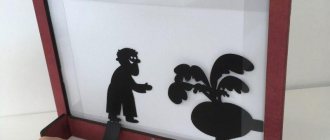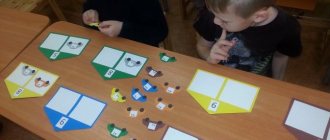"Shadow theater as an educational game"
"Shadow theater as an educational game"
Ordinary shadows can be a reason for creativity, fun and educational games!
Shadow games
If you notice your own clear and beautiful shadows on the wall, do not rush to pass by. Together with your child, observe how they change when you move or take a pose. The shadows will follow your every step! The baby can play with the shadow with a ball, practicing throwing it straight and evenly or into the “hands” of his mother’s shadow. You can draw eyes or ears on the wall with chalk in advance, and then squat or bend so that these details “attach” correctly to your shadows.
Shadow play
Preschoolers are attracted to shadow theater for its unusualness, built on the contrast of light and shadow, and its dynamics; it brings great pleasure and a lot of joy. Such theater arouses interest in children no less than other types of theater. In the shadow theater, children see the animated and speaking silhouettes of familiar characters.
The mystery and unusualness of the spectacle captivates the child, transporting him to a completely special, fascinating world, where everything is unusual and everything is possible. Children quickly succumb to emotional influence and are actively involved in the theatrical performance, reacting vividly to what is happening.
Empathizing with the characters of the play, they actively answer the characters’ questions, willingly carry out their instructions, give advice, and warn of danger. An emotionally experienced performance helps determine children’s attitude towards the characters and their actions. Children of early and preschool age are very impressionable, so they succumb to the strong, emotional influence of shadow theater. However, they are interested not only in watching the performance. Children are ready to take an active part in creating their own theater. Preparing screens, scenery, puppets, creating and discussing scripts, showing the performance to children, parents, and grandparents - all this is available to preschoolers, and therefore extremely captivates them with new opportunities to be successful in creative activities and positive communication.
Then you can prepare genre skits and performances based on short literary works.
Shadow theater has its own characteristics: the immobility of silhouettes, the lack of perspective, depth, the impossibility of placing one silhouette after another - this is largely the specificity of working on staging a shadow play with preschoolers.
Developing the importance of shadow theater
1. Shadow theater develops a child’s imagination and teaches him to think creatively.
2. During a shadow theater show, the child draws and completes elements in his head that are not shown, and such a thought process is very useful. Shadow theater develops creative thinking and imagination.
3. Shadow theater develops a child’s speech. The child puts on a play and speaks out loud on behalf of the characters. Here it is important for a parent or other adult to be his spectator. Let the child feel free to invent and tell a story. Support your child's story with admiration and questions.
4. Shadow theater calms children before bed, because the game takes place in the dark and in a calm atmosphere, and you can use musical compositions.
5. The child realizes that the result of his work can be a puppet for the shadow theater and the performance itself. Thus, there is a feeling of oneself as a creator, and not just a consumer of various services and goods.
6. Shadow theater helps to overcome children's fear of the dark, since the associative series of “monster under the bed” and “scary creatures in the darkness of the room” is overlapped by an association with the solemnity of the performance, a miracle in the dark.
7. Shadow theater creates family traditions and warm relationships with parents. Of course, provided that the parent participates in the child’s performance!
When creating shadow theater, the role of adults is priceless! After all, you can create a special atmosphere that will be remembered for a lifetime, like pleasant childhood memories.
Shadow theatre, unlike other types of theatre, does not require lavish costumes and complex sets. It is based on the play of light and shadow.
To organize it, three elements are needed:
a screen, a light source and actors - shadow figures
, which can be played by both people and the most ordinary objects: paper or cardboard figures, toys, dishes and much more that is at hand, and It is feasible for children to make it together with a teacher or parents. Shadow theater can be done quickly. First you need to make a screen. In the simplest case, the screen consists of a thick cardboard frame and thin fabric. When gluing, you must pull the fabric tightly onto the frame.
There should be as few irregularities on the surface as possible; this determines how clearly the shadows - the actors - will appear. You can decorate the interior according to the plot of a fairy tale. If the action takes place in a forest, you can cut out silhouettes of branches and glue them to the frame from the inside. If in a castle, you can cut out the columns. An important point for shadow theater is the installation of light. The light should come from behind and from above. Silhouettes must be
between the light source and the screen. Between the light source and the screen, dolls cut out of paper, hands, finger theater figures, and the human actors themselves can be placed and play.
Silhouette pictures or silhouettes can be made from ordinary paper, cardboard, leather, wood, plywood, metal. Shadow theater figures are very easy to make. Silhouettes can be prepared on a computer, found on the Internet, or drawn yourself, printed on regular A4 sheets.
According to the drawing, cut out silhouettes from thin cardboard and attach a paper tube to them.
What they see and experience in the theater broadens the children’s horizons, creates an atmosphere, requires the children to engage in conversation, all this contributes to the development of a creative personality, the ability to conduct a dialogue and convey their impressions in a monologue. Develops: creativity, imagination, fine motor skills, thinking, memory, speech.
At the initial stages of introducing children to the art of shadow theater, only adults (teachers and parents) take part in the preparation and performance of the performance, but gradually children are also involved. First, they act out sketches - improvisations, joke and have fun, experimenting with the shadow of their own body (or its parts - head, hands), toys, flat figures and various objects. And along the way they learn to control the shadow, “revitalizing” it in small productions.
Creating an atmosphere
1. Before the theater is shown, the plot of the fairy tale must be invented. Make up a story or use a famous fairy tale. You can fill a previously read story with new content.
2. For the performance, dolls must be prepared for acting. Let your child collect his own collection of shadow puppets and learn how to make them.
3.Process. You can set a task for your child in the morning and show you a performance in the evening. Give him a fairy tale, theater for rehearsals and let him learn responsibility and prepare events. You can also do this all together with your child and even extend the game over a week. We’ve been preparing the play since Monday, and on Saturday my grandparents will come and we’ll show it to them together. You will be surprised at how responsibly your child will approach this task.
4. Select background classical music for the performance. It will create a solemn magical atmosphere for the game. Play it in the background at a volume below average. This is not a mandatory item, try both the option with silence and with music, and choose the one you like best.
5. Show of the performance. Turn off the lights. When playing shadow theater, there should be one light source in the room - either a regular flashlight or a smartphone flashlight. It is better to buy an ordinary powerful flashlight for a shadow theater. You can also use a flexible table lamp where you can direct the beam of light while maintaining safety guidelines.
6. Turn off the TV. Remove all unnecessary sound stimuli. The focus is on the screen itself and the artists.
7. Enjoy the atmosphere of creativity and magic!
Good luck to you in your joint work!
Children's page
Draw a line from the character to his shadow
Downloaded from www.znanio.ru








